_600.jpg) |
| Alice Winocour on Disorder: "I thought also about Carpenter's films, the sound." |
Following her enticing and spirited debut, Augustine, Alice Winocour again proves that she can package troubled states of mind in lush images and strong plots. Disorder (Maryland), written with Jean-Stéphane Bron, stars Matthias Schoenaerts (Jacques Audiard's Rust And Bone) and Diane Kruger with Paul Hamy (Katell Quillévéré's Suzanne, Maïwenn's My King), Zaïd Errougui-Demonsant, and Percy Kemp.
 |
| Vincent: "What is frightening for the character is to not have control over his own body." |
Pascaline Chavanne's costumes (Jacques Doillon's Rodin, Emmanuelle Bercot's Standing Tall, Christophe Honore's Métamorphoses), Stanley Kubrick's Eyes Wide Shut, Michelangelo Antonioni's La Notte, Vincent Lindon, László Nemes's Son Of Saul, Guillaume Nicloux's Valley Of Love, Michel Houellebecq's Submission, Julien Lacheray's editing, Gesaffelstein's sound, John Carpenter, David Lynch's Lost Highway and William Holden - all were addressed in my Rendez-Vous with French Cinema conversation with Alice Winocour.
Disorder, from the very start attaches us to Vincent (Matthias Schoenaerts), a soldier returning from Afghanistan. The remarkable sound design links the noises in his head to the present, where he works as a security guard, protecting an influential Lebanese businessman's wife Jessie (Diane Kruger) and son Ali (Zaïd Errougui-Demonsant) in their immense chateau while the husband Imad (Percy Kemp) is away on a trip to Switzerland.
Never quite sure if what we see stems from Vincent's paranoia or is a real threat due to the husband's links to high government officials, the intense, exquisitely paced drama unfolds like a thriller.
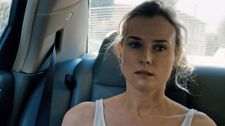 |
| Jessie: "It's this doubt that for me is the main ingredient of a paranoiac thriller ..." |
Anne-Katrin Titze: There are quite a few films that begin on the back of a character. We are on the back of Isabelle Huppert, for example, at the start of Valley Of Love.
Alice Winocour: I remember the shot.
AKT: But yours reminded me most of the beginning of Son of Saul. That's the kind of terror we feel being with Vincent [Schoenaerts]. Also with the sound design, you throw us into a world where anything could happen.
AW: Yeah. I haven't seen Son Of Saul but what is in common, I think, is the perception. What was really important to me was to be in the perception and the single point-of-view of the character. From the first sequence, I really wanted the audience to be in his body. In his ears! The film is almost a sensory experience. I wanted it to be really carnal and physical.
AKT: The sound helps to do that in particular.
AW: We did a huge amount of work on the sound to create this mental landscape of a soldier. The sound had to convey the fragility of perception and this difficulty of the character to cope with normality, coming back from a war zone. Small details, like breathing in the mixing was a very important part of the process. Also, sounds are altered. It begins really like a documentary on a soldier.
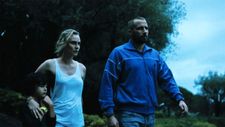 |
| Ali (Zaïd Errougui-Demonsant), Jessie (Diane Kruger), Vincent |
As the film runs, we sink into more like a fantasy or a nightmare or like a horror movie. There is no flashback in the film. I knew that the music had to express the violence of war and also the physical condition. All the soldiers that I met told me about their nightmares, their outbursts of violence and all these physical symptoms, that are referred to as PTSD symptoms.
AKT: The music and sound combination is very threatening to an audience. We feel that anything could happen at any moment. Lots of things do happen. Did you start the movie before Charlie Hebdo?
AW: Before. It's interesting that you ask this. When I was editing the film, my editor [Julien Lacheray] received a message, saying, "Are you in the street? Go back home. There's a problem." And it was the Charlie Hebdo attack. Then it was amazing to me when I was going out of the editing room, I was seeing military with guns in the street. I felt really that the nightmare had come real for real.
AKT: Wow. There is a real similarity in the feeling you get from your film.
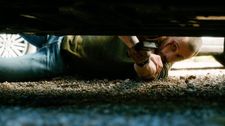 |
| "You know something frightening is going on." |
AW: And also what is really strange to me is that my little brother was in the Bataclan attack and he survived, thankfully. It was also something really strange that he became like the character, suffering from PTSD himself. It was really weird having worked for such a long time on this subject and suddenly to have my little brother experiencing something like that.
But what I really wanted to show in the film was the idea of a danger or a threat and you never know if the threat is real or if it's the effect of your paranoia. What I feel now, what is happening in Paris is this: now we are back to a normal life but when you hear a sound that is a little louder, everyone is like … That's what we call hyper-vigilance.
AKT: In New York we know that very well.
AW: Two days later, people hear a little sound and start to have panic attacks. Some people were like running in the street and people seeing other people running started to run. So there were hundreds of people running but it was unreal. As the film shows. All the fears become real. Of course, I am thinking about those men that are suddenly in the house.
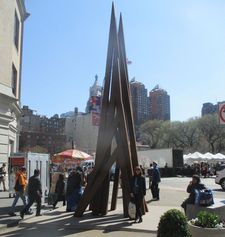 |
| Bernar Venet's Disorder: 9 Uneven Angles at Union Square Photo: Ed Bahlman |
They pop up like this with these black things on their heads and guns and it reminds me really of the attack in the Bataclan, what people there felt like. To me the house is almost like a character. With this garden, very peaceful garden. I thought also about Carpenter's films, the sound.
AKT: John Carpenter's films?
AW: About scary things happening far away behind the walls of the garden. You can hear the sounds and it's scary because there is a contrast between the appearance of calm but you know it's unreal. You know something frightening is going on.
AKT: Something big. I felt a shift in tone in quite a few of the French films this year. Almost as though some premonition was in the air. Michel Houellebecq's novel Submission has some of that mood, too.
AW: It's really interesting. It's this feeling of a constant flow of information coming. This feeling of being there, being in the room and of not understanding anything that is going on. What is frightening for the character is to not have control over his own body. At the party, he hears things but he is not sure what he heard. It's about politics and all those corrupt politicians.
AKT: He is like us. We don't know what is going on.
 |
| Jessie with Vincent: "... there is a contrast between the appearance of calm but you know it's unreal." |
AW: Yes. There's inquiries but it still remains shady. It's this doubt that for me is the main ingredient of a paranoiac thriller - that you never know if it's fantasy. The dog, for example, is playing with the grammar of genre film.
AKT: Let's talk about the dog. First of all, you call the dog Ghost, which is lovely. Secondly, I connected the dog to the monkey in Augustine.
AW: That's true.
AKT: Of course, in a thriller and a house like that, you worry about the dog. Well, I worry about the dog. Thinking of your use of the monkey, made me worry less that you would do something to it - unlike other filmmakers. Did you read the article in The New York Times Magazine earlier this year about veteran therapy with birds [What does a parrot know about PTSD?]?
AW: No. Have you read Yellow Birds? It's a fantastic novel by an American writer [Kevin Powers], really also a lot about the sensation of PTSD. Also, I spent a lot of time with soldiers in this hospital and I became really close with two of them. I was writing the film for two years - I was writing also other films, like Mustang, but it was a long process of writing. They were telling me stories constantly about their own experience.
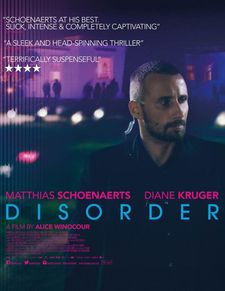 |
| Disorder US poster |
They told me when they were coming back from combat zone, it was impossible to have a relationship with humans anymore. Because they had seen such terrible things. PTSD - the thing is to be exposed to death, either your own death or somebody else's. It's like being in limbo, that you are not sure. There is no word to describe this violence.
AKT: That's where contact to animals comes in?
AW: Exactly. They said, the only ones we could relate to were animals - and dogs because we felt more like them.
Coming up - Alice Winocour on Antonioni's La Notte, Kubrick's Eyes Wide Shut, Rust And Bone, Augustine with Vincent Lindon, Pascaline Chavanne's costumes, alluding to Beauty And The Beast, Lost Highway and William Holden.
Disorder opens in the US on August 12. Alice Winocour will participate in a Q&A following the 8:00pm screening this Friday at the IFC Center in New York.





















